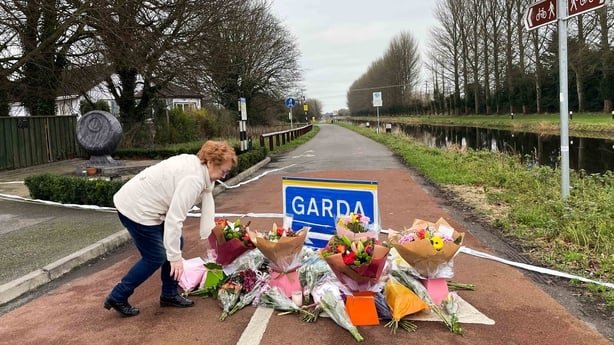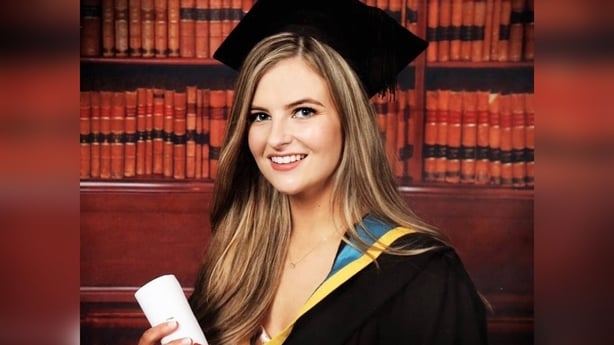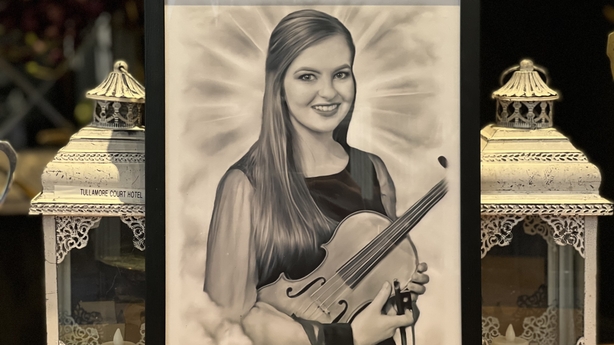The jury in Jozef Puska's trial heard details of how, when and where Ashling Murphy was murdered. And it heard details of Puska's movements before, during and afterwards. However, we are still no closer to knowing why Puska carried out this random attack.
RTÉ's Legal Affairs Correspondent Órla O'Donnell looks back at what we learned during the three week long trial.
She was just going for a walk. Less than an hour later she was dead.
Ashling Murphy was in her hometown. It was a bright, clear, sunny afternoon. She was wearing runners, tracksuit bottoms, a GAA shirt, a zip-up jacket, a scarf and a bobble hat. There were plenty of other people around the Grand Canal Way, cycling, walking, running, working.
Jozef Puska didn't know Ashling. They’d never met. Despite a widely spread rumour that Ashling had contact with him or his family through her work as a primary school teacher, the truth was that there was absolutely no connection between them.
And yet shortly before 3.30pm in the afternoon of 12 January last year, Puska overpowered Ashling halfway through her walk, stabbed her 11 times in the neck, sliced her neck with another cut from his knife and left her to die in a ditch.
The question that may never be answered, is why?

Ashling wasn’t the first woman Puska had targeted that day.
Firstly he followed Beata Barowska as she headed to Tesco in the Cloncollig retail park at 1.38pm. He had no intention to follow her, he said, he was simply cycling slowly behind her.
But the CCTV footage compiled by gardaí from more than 25,000 hours harvested and viewed by them, showed something much more sinister.
As Ms Barowska walked towards the retail park to do her shopping, Puska cycled behind her, within a few feet of her. When she got to the retail park he followed her across the car park, cycling slowly with his hand in his pocket. As she headed to the entrance of Tesco, he cycled down a service road at the side of the building, emerging to have one final look towards Ms Barowska as she entered the shop, before appearing to give up and head back the way he came.
In one piece of footage he appeared to stop briefly on his journey, take something out of his pocket and examine it before putting it back into his pocket.
Shortly afterwards, just before 2pm, he started following another young blonde woman who was out walking her dog. This time the woman, Anne Marie Kelly, noticed somebody behind her. She stepped in to let Puska pass but he didn’t pass her. She moved in again and this time he passed her in "really, really slow motion" staring at her, in what she said was an intimidating way, as he passed.
She saw him again down by the canal and she described in detail how he walked behind her with his bicycle and made her feel uncomfortable and nervous. Eventually, she jogged past him.
Multiple people close to the case have described both women as "lucky".

Ashling Murphy was still at work while this was going on, teaching her class of six and seven year olds in Durrow National School, around eight kilometres away. At 2.30pm, classes finished for the day and seven minutes later, the 23-year- old was caught on a CCTV camera at the school striding towards her red Seat car in the car park.
Her parents, sister, brother and boyfriend saw these images for the first time as they were played to the court in pretrial legal argument over the admissibility of the CCTV evidence. It was 2.37pm when Ashling headed towards her car. She had less than an hour to live.
She drove straight to the Daingean Road car park along the banks of the Grand Canal in Tullamore. She was unaware that Puska had been hanging around the area on his bicycle or that he had been making Anne Marie Kelly feel uncomfortable and nervous as she walked along the opposite side of the canal a short time earlier.
At 2.51pm Ashling began her exercise, walking briskly for just under three kilometres along the canal towpath towards Digby Bridge. The final images of her were captured on CCTV at 2.55pm.
Her Fitbit recorded her travelling in an easterly direction, her heartrate raised from the walk. At some point along her route, it appears she may have met Ms Kelly, who described chatting to a "lovely, friendly, smiley girl" who petted her dog. At 3.16pm she got to the bridge and turned around to head back along the path towards the car park.
Five minutes later, everything changed. The Fitbit data suggests Ashling was taken completely by surprise. Her heart rate didn’t spike with fright or shock - instead it began to decrease rapidly. The location data became erratic suggesting the device was moving frantically, violently. At 3.27pm there was a small spike in her heart rate before it disappeared completely at 3.31pm.
The Fitbit data was first illustrated to the court by garda analyst Ciaran Byrne on a graphic which showed a small figure travelling along a map. At the end of the prosecution case, it was shown again to the jury in evidence given by another analyst, Ian McPhillips.
Mr McPhillips had compiled a document and PowerPoint presentation for the jury members to help them in their deliberations. His evidence was not expected to be particularly noteworthy as the details had been heard already. But as the little white dot representing Ashling in the graphic moved along the map towards Digby Bridge, her mother Kathleen began to sob.

Puska cut Ashling’s neck on her right side 12 times. Eleven of the wounds were stab wounds, meaning that they were deep rather than long. Her voice box was cut all the way through, which meant she would have been unlikely to have been able to shout for help or make an intelligible sound. Her right and left jugular veins and her right carotid artery were damaged.
The court heard she would have lost so much blood that she would have gone into cardio-respiratory arrest. She had defensive injuries to her hands probably caused by her efforts to save herself. Her attacker’s DNA was under her fingernails.
Eyewitness Jenna Stack saw what may have been the final stages of the attack. She and her friend Aoife Marron, also primary teachers out for some exercise along the canal, were stopped in their tracks, firstly by a bicycle oddly abandoned on some brambles and then a few seconds later by loud rustling in the ditch beside them.
Ms Stack looked into the undergrowth and saw Puska holding Ashling down as she kicked her legs. Her voice broke in the witness box as she described the girl she saw "kicking so hard", fighting for her life, "crying out for help", by using the only part of her body she could move.
Neither woman had a mobile phone but Jenna shouted that she was calling the guards and to "get off her", before they sprinted as fast as they could to get help. At Digby Bridge, local man Enda Molloy cycled back to the location after hearing what the women had seen. He saw the bicycle and then, the body of a young woman in the ditch, her face covered by her "blondey-brown hair", matted with blood.
Mr Molloy rang for help. Gardaí at Tullamore Garda Station received a call some time between 3.30pm and 3.35pm. When they arrived at the canal bank, the gardaí tried desperately to resuscitate Ashling for up to 15 minutes. Paramedics arrived, and they lifted her body from the briars and brambles to continue to work on her. But they knew immediately it was futile. The 23-year-old school teacher and gifted musician was dead.
Puska claimed he'd never seen Ashling and didn’t know her. He said he couldn’t recall his confessions
Puska, meanwhile, was lurking in a ditch not far away. He finally emerged after more than four hours and was spotted by at least two witnesses "tucking himself in" and "crouching" as he walked along the side of the Tullamore bypass, in the dark, towards the town, apparently attempting not to be seen.
He called to a friend’s house, told him he’d been attacked and asked for a lift home to Mucklagh. From Mucklagh he fled to his parents’ apartment in Dublin. Footage showed him entering the apartment, with his mother and father, with no apparent injuries or difficulties in walking. He emerged the following morning, being carried into an ambulance with stab wounds to his stomach.
He told gardaí he’d been stabbed in Blanchardstown the previous day. But the following evening, 14 January, he confessed to gardaí from Tullamore that he was the murderer. He spoke through a Slovak interpreter, saying "I did it. I murdered. I am the murderer." He expressed concern about his family as well as fear that Ashling’s family could seek revenge and he continued talking even after being told he didn’t have to say anything more and that gardaí would get him a solicitor.
"When she pass, I cut her neck," he said, this time in English. "She panic, I panic." It wasn’t intentional he said and he regretted it. Pointing at his own stomach, he said "I do this".
That was the last insight Ashling’s grieving family got into the events at the Grand Canal on 12 January.
In custody, four days after making the admissions, Puska claimed he’d never seen Ashling and didn’t know her. He said he couldn’t recall his confessions.
During the trial, he blamed it all on a mysterious, unknown man in a surgical mask who had stabbed him in the stomach for no apparent reason before murdering Ashling. It’s understood he had previously given a different version of events to others.
In the witness box, he again said he couldn’t recall his confessions. He tried to claim he was confused and possibly delirious as a result of the pain relief he’d been given in hospital. This was in spite of expert evidence that his admissions couldn’t possibly have been influenced by the low doses of oxycodone he had been administered.

Ashling was not sexually assaulted. And some gardaí involved in the case do not believe the motive for the attack was sexual.
In the witness box, Puska attempted to paint a picture of a quiet domestic life. Unable to work due to a back injury, he said he spent his days looking after his young children, bringing the older ones to and from primary school and carrying out chores in the home. He told gardaí he drank only occasionally.
The court ruled that CCTV footage of Puska in the Pot of Gold casino in Tullamore in early January which the gardaí had used to identify him in the distinctive clothing he was wearing when he murdered Ashling ten days later could not be shown to the jury. Mr Justice Tony Hunt ruled that showing such footage would be more "prejudicial than probative".
Puska told the jury he would not have been out following women around Tullamore because he had no reason to - he had a wife at home. There appears to have been no obvious reason either for the father of five young children to stab a young woman to death in a random attack in broad daylight in the middle of the afternoon. He has shown little sign of remorse or empathy.







